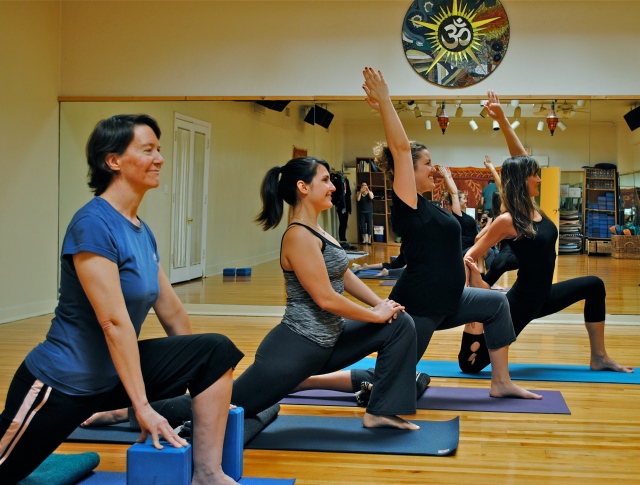What it means to modify your yoga practice and why everyone should feel empowered to make changes to their practice during group classes.
One of the biggest differences between a beginning yoga student and a more advanced student is their ability and willingness to modify poses during class. Sometimes the best pose for your body that day is not the one the instructor just called out. Adapting a posture to better suit your energy, strength or flexibility is a sign of a conscientious practitioner who is connected to and honors their body. Knowing how to modify a posture to be easier or more difficult is only half the battle – it’s also important to consider why a modification will enhance your practice.
We’ve all been there before, the new kid in class trying to hide in the back when the instructor guides everyone into tree pose. You shakily lift one leg off the ground and place it against your other leg, concentrating as hard as you can to avoid toppling over when the half-flamingo, half-model instructor guides the class to “leave your hands on your hips, bring them together in front of your heart or grow your branches up towards the sky!” Glancing around the room, you notice that most people are reaching their arms upwards, so you try too and flail your lifted foot to the ground.
In this example, the options for arm position reflect increasingly challenging options for balance. Keeping the hands on the hips brings them in line with the body’s center of gravity, increasing stability. Bringing the hands to the heart helps a student check in with the midline of their body, still providing stability but moving further away from that center of gravity. In contrast, raising the arms overhead introduces an element of instability to challenge a more experienced student’s balance. The arm position appropriate for you depends upon how experienced you are with balancing on one leg and how grounded you feel on that particular day.
Luckily, there are some rules-of-thumb for when it’s appropriate to modify a pose and how to determine which modification is right for you!
1. Go With The Flow. In a vinyasa or flow class, instead of trying to modify each pose during a sequence or dropping into child’s pose halfway through, try to stay with the class for one whole sequence on each side of the body. Rest in downward facing dog or child’s pose during repetitions of the sequence and rejoin the class the next time they come to downward dog or a forward fold.
2. Pay Attention to Order. When teachers offer several different modifications for the same pose, they’ll usually begin with the most basic and work up to a more advanced variation. For example, you might start out by holding plank pose with the knees on the floor, the next option would be to lift the knees so your whole body is parallel to the floor, then you could bring one knee to touch your arm and from there advanced students might come into an arm balance. Don’t worry about being the only person in the room with your knees still on the floor – it’s better to challenge yourself with something you can do rather than risk injury attempting the flashiest variation offered.
3. Know Your Limits. Strike a balance between challenging yourself with poses and variations you’ve never tried before and recognizing your ability level. Yoga teachers everywhere breathe easier when they see a new student stay with the most basic form of a pose for a few weeks. When you can practice the basic variation with ease, go ahead and try out the next step! Maybe you’ll get it right away and maybe you’ll need some more time to work up to it – that’s why it’s called yoga practice, not yoga perfect.
4. Every Day is Different. Even if you can sink your thigh parallel to the ground in extended side angle and bind your arms with ease, you may not feel like pushing yourself to the max if you’ve had a long day at the office. Determine your energy level at the start of class and honor your body if it tells you to rest. After a long day, even the most experienced practitioners prefer to stick to the basics, focusing on a deep connection between body and breath.
5. Sometimes It’s All About Style. Slight variations in form exist between different styles of yoga. Some schools of yoga teach that the feet should be touching during a sun salutation and others prefer the feet to be placed hip-width distance apart. Some teachers will ask that you interlace the hands overhead in Warrior I, others will expect your arms to reach straight up towards the ceiling. In general, these types of variations are simply a question of style. Be open to trying new styles but also feel free to stick with what you know and try to be gracious if the teacher comes around to correct you.
6. Ask Questions! Lastly and most importantly, don’t be afraid to ask questions before or after class. Explain which poses you find to be difficult and ask if the teacher has any suggestions on how to modify or refine your practice. If the teacher came and adjusted your alignment during class and you’re not sure why, ask and you’ll remember next time how to make the adjustment yourself.
Hopefully these tips give you the confidence to modify and experiment with your practice during class. Yoga can be an amazing journey of self-discovery and empowerment as long as you step onto your mat with a student’s heart, willing to learn whether it’s your first time or your ten thousandth.

